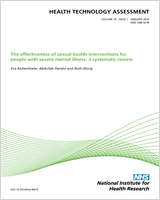Included under terms of UK Non-commercial Government License.
NCBI Bookshelf. A service of the National Library of Medicine, National Institutes of Health.
Headline
Study found that discrete event simulation can be used to model full guideline pathways for cost-effectiveness analysis, although this requires a substantial investment of clinical and analytic time and expertise. For some topics lack of data may limit the potential for modelling. There are also uncertainties over the accessibility and adaptability of full guideline models. However, full guideline modelling offers the potential to strengthen and extend the analytical basis of the National Institute for Care and Excellence’s clinical guidelines.
Abstract
Background:
National Institute for Health and Care Excellence (NICE) clinical guidelines (CGs) make recommendations across large, complex care pathways for broad groups of patients. They rely on cost-effectiveness evidence from the literature and from new analyses for selected high-priority topics. An alternative approach would be to build a model of the full care pathway and to use this as a platform to evaluate the cost-effectiveness of multiple topics across the guideline recommendations.
Objectives:
In this project we aimed to test the feasibility of building full guideline models for NICE guidelines and to assess if, and how, such models can be used as a basis for cost-effectiveness analysis (CEA).
Data sources:
A ‘best evidence’ approach was used to inform the model parameters. Data were drawn from the guideline documentation, advice from clinical experts and rapid literature reviews on selected topics. Where possible we relied on good-quality, recent UK systematic reviews and meta-analyses.
Review methods:
Two published NICE guidelines were used as case studies: prostate cancer and atrial fibrillation (AF). Discrete event simulation (DES) was used to model the recommended care pathways and to estimate consequent costs and outcomes. For each guideline, researchers not involved in model development collated a shortlist of topics suggested for updating. The modelling teams then attempted to evaluate options related to these topics. Cost-effectiveness results were compared with opinions about the importance of the topics elicited in a survey of stakeholders.
Results:
The modelling teams developed simulations of the guideline pathways and disease processes. Development took longer and required more analytical time than anticipated. Estimates of cost-effectiveness were produced for six of the nine prostate cancer topics considered, and for five of eight AF topics. The other topics were not evaluated owing to lack of data or time constraints. The modelled results suggested ‘economic priorities’ for an update that differed from priorities expressed in the stakeholder survey.
Limitations:
We did not conduct systematic reviews to inform the model parameters, and so the results might not reflect all current evidence. Data limitations and time constraints restricted the number of analyses that we could conduct. We were also unable to obtain feedback from guideline stakeholders about the usefulness of the models within project time scales.
Conclusions:
Discrete event simulation can be used to model full guideline pathways for CEA, although this requires a substantial investment of clinical and analytic time and expertise. For some topics lack of data may limit the potential for modelling. There are also uncertainties over the accessibility and adaptability of full guideline models. However, full guideline modelling offers the potential to strengthen and extend the analytical basis of NICE’s CGs. Further work is needed to extend the analysis of our case study models to estimate population-level budget and health impacts. The practical usefulness of our models to guideline developers and users should also be investigated, as should the feasibility and usefulness of whole guideline modelling alongside development of a new CG.
Funding:
This project was funded by the Medical Research Council and the National Institute for Health Research through the Methodology Research Programme [grant number G0901504] and will be published in full in Health Technology Assessment; Vol. 17, No. 58. See the NIHR Journals Library website for further project information.
Contents
- Scientific summary
- Chapter 1. Background
- Chapter 2. Overview of methods
- Chapter 3. Stakeholder surveys
- Chapter 4. Case study 1: full guideline model for prostate cancer
- Introduction
- Methods
- The conceptual model
- The disease process model
- Final model design
- Detailed model description and programming logic
- Evidence used to inform the model parameters
- Modelling decision options across the service pathway
- Results
- Summary of economic results and implications for updating guideline topics
- Discussion
- Usefulness of the broader modelling approach
- Chapter 5. Case study 2: full guideline model for atrial fibrillation
- Chapter 6. Discussion
- Acknowledgements
- References
- Appendix 1 Modelling Algorithm Pathways in Guidelines study protocol
- Appendix 2 Guidelines considered as case studies
- Appendix 3 Stakeholder survey responses
- Appendix 4 Prostate cancer service pathway
- Appendix 5 Prostate cancer data for update topics
- Appendix 6 Atrial fibrillation clinical pathway
- List of abbreviations
Article history
This issue of the Health Technology Assessment journal series contains a project commissioned/managed by the Methodology research programme (MRP). The Medical Research Council (MRC) is working with NIHR to deliver the single joint health strategy and the MRP was launched in 2008 as part of the delivery model. MRC is lead funding partner for MRP and part of this programme is the joint MRC–NIHR funding panel ‘The Methodology Research Programme Panel’.
Declared competing interests of authors
none
- NLM CatalogRelated NLM Catalog Entries
- Economic modelling of diagnostic and treatment pathways in National Institute fo...Economic modelling of diagnostic and treatment pathways in National Institute for Health and Care Excellence clinical guidelines: the Modelling Algorithm Pathways in Guidelines (MAPGuide) project
Your browsing activity is empty.
Activity recording is turned off.
See more...
